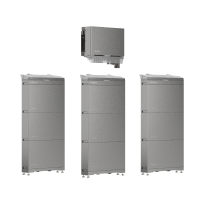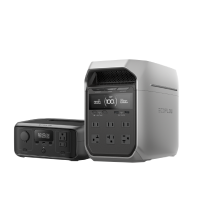What is a Solar Power Grid tie Inverter and How Does it Work?
The uptake of renewable energy in the United Kingdom continues to soar year on year, thanks to a continued focus on green technologies. The general public is becoming more aware of the wide range of benefits that are provided by home solar energy, and there's a growing movement toward cleaner options. Today, we look at an essential part of these new systems - the solar power grid tie inverter.
Now, to the casual observer, it's a component that doesn't look like much, but the work it does is crucial to what a grid-connected home solar battery system does. A gizmo like this in your home battery setup needs to be there for a whole raft of reasons - something we explore more deeply throughout this article.
What kind of product or solution are you interested in?


A Solar Power Grid Tie Inverter is Part of a Larger System
It's common knowledge that solar power harnesses the sun's energy, but how it's transformed into usable, clean electricity is not so widely understood. So, before we look at the specific role of a solar power grid tie inverter, here's a brief, step-by-step breakdown of how it's done.
- Step #1 - Abundant energy is emitted by the sun and collected by the familiar solar panels seen on many roofs across Britain. Constructed from semiconductors, glass and intricate wiring, these panels absorb photons from sunlight, which starts the flow of electrons to generate direct current (DC) electricity.
- Step #2 - This direct current is converted to alternating current (AC), as your property's power system can't use the electricity otherwise.
- Step #3 - The energy is either used immediately to power your home's appliances, stored for use later in hybrid equipment like the PowerOcean homebattery solution or sold directly back to the grid.
These are the basics, and there's a need for a grid tie inverter (or hybrid inverter) for every type of solar power system, so long as it's not off-grid. Naturally, in the case of an independent, self-contained home solar battery system, an off-grid inverter is used.
So, What is a Grid-Tie Inverter?
Basically speaking, a solar power grid tie inverter comes into play during step two shown above, as it’s part of the DC to AC conversion process. Without it, the gathered power couldn’t power your home and their key features typically include:
- High-Efficiency Rates: These inverters are designed to offer optimal conversion of DC to AC, with many types achieving efficiency rates above 95%. This high efficiency ensures minimal energy loss during the conversion process.
- Varied Power Capacity: No two homes are ever quite the same, which is why solar power grid tie inverter equipment is available in a variety of different power capacities. Again, this ensures not a single watt of power is wasted.
- Smart Monitoring Capabilities: When connected to smart monitoring systems like the EcoFlow PowerInsight Home Energy Manager, the best types of grid tie inverters allow your systems’ performance to be monitored in real time.
Furthermore, you’ll find that many kinds of solar power grid tie inverter hardware will include a range of built-in safety features, such as automatic disconnection from the grid during power outages to prevent harmful and potentially dangerous electricity feedback.
How Does a Grid-Tie Inverter Work?
Ok, so we’ve covered the fundamentals. The job of a grid-tie inverter is to switch the obtained power from DC to AC, but it is a little more complicated than that. You see, it also needs to decide whether to feed the electricity to your home or send it back to the grid. The decision whether to do one or the other breaks down a little something like this.
Generation vs Consumption of Electricity
Part of the process involves the grid tie inverter constantly monitoring the amount of electricity being generated by your solar panels and how much you’re using. Should there be an excess of electricity, it will be sent back to the grid. If you have a hybrid system, a grid tie inverter’s job will be performed by a hybrid inverter, which also has the option to send the excess to your home battery.
Net Metering
When excess electricity is sold back to the grid, it’s broadly referred to as net metering, which in the UK is known as the "Smart Export Guarantee" (SEG). Introduced in 2020, the SEG allows homeowners to export energy back to the national grid in exchange for credits on their energy bills - effectively turning the energy dial backward!
Grid Synchronization
Before it can be fed back, a grid tie inverter must first ensure that the voltage and phase and frequency of the electricity matches the grid’s requirements. This synchronisation is necessary for safety, regulatory compliance and efficiency reasons and they’re programmed to change the electricity in the appropriate way.
The decisions made by your solar power grid tie inverter are part of a dynamic process that’s adjusted in line with conditions that can change in real time.
Benefits of Having a Grid-Tie Inverter System
While standalone, off-grid home solar energy setups have their own advantages, those connected to the grid bring with them a range of advantages. As such those that feature a hybrid or solar power grid-tie inverter represent a wise investment for the following reasons.
- Cost-Effectiveness & Savings: The most obvious benefit of a system like this is the potential for huge savings on your energy bills. Sure, there’s an upfront cost that needs to be met, but over time, it doesn’t take too long to recoup your investment.
- It’s quite common for solar panel systems to generate more energy than a home uses, particularly during the summer. This means that you can save a lot of money against any power you use from the grid.
- Supporting the Environment: Another advantage offered by a grid tie inverter setup is that it greatly reduces your reliance on fossil fuels. Whether installed in a home or business premises, the result is a lower carbon footprint and the more that people give back to the grid, the less it has to produce using conventional means.
- Increased Energy Independence: The energy market can be volatile and there’s been a distinct upward trend to prices in the UK over recent years. However, when you have a grid-connected home system, you get the reassurance of constant energy supply when you need it along with a degree of energy independence.
Want to Enjoy the Advantages of a Home Solar Energy System?
While it’s an unassuming component within the home energy setup, the solar power grid tie inverter is the silent hero that makes all the advantages we’ve mentioned possible. Energy independence, low energy bills and complete control over what your home uses are just three of the ways that you can benefit from investing in a system that has one.
At EcoFlow, our home battery systems let you enjoy everything we’ve described here while also allowing you to store energy for later use. What’s more, our systems offer unrivalled reliability and durability, which is why they come with a 15-year guarantee.
So, if you’re interested in reducing the carbon footprint of your home and enjoying lower energy bills, please take a look around our website, Homebattery.ecoflow.com/uk. Alternatively, if you'd like to chat about your requirements with our team, simply head to our homepage and click 'Order Now' for a free quote tailored to your requirements.



